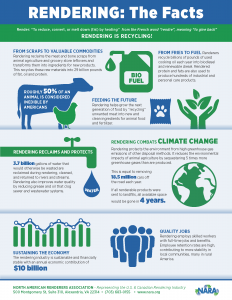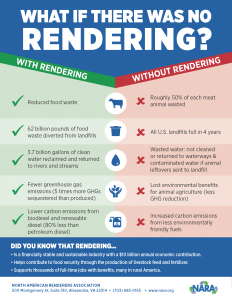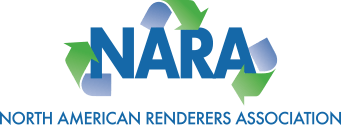From the perspective of NARA’s newest staff member, Communications Director Anna Wilkinson

When I started work at NARA nearly two years ago, I was struck by the scant amount of information publicly available about rendering when I searched for it. Yes, our association had an informative website with educational resourcces on rendering specifically, but a general, online search of “rendering” yielded every definition except the one that explains what we do.
Top results were “architectural rendering”, “computer graphics rendering,” and even such specific definitions as “a performance or a piece of music or drama” and “the action of applying plaster to a wall” …. But no easy-to-find results on the “processing and recycling of unused animal meat leftovers for new products, like safe and nutritious pet food, biofuel, tires and even fireworks.” That’s the important work the “renderers” do.
If I had seen that definition of rendering, I would have thought to myself:
“This is so great! What an important solution to help reduce food waste. What a sustainable process! Why don’t more people know about this?”
And in fact, that is exactly what I thought (and probably said) in my first interview for my current position as Director of Communications for NARA.
Up to that point, I’d never heard of any process more worthy of the Sustainable title (with a capital “S”) than rendering. I felt like it should’ve been up in lights over every rendering plant and every company upcycling animal leftovers and used cooking oil to make valuable ingredients for hundreds of new goods.
It was as if I had discovered a whole new way to be sustainable, and it had been going on all around me for years – literally hundreds of years. I was so excited, I just wanted to shout from the rooftops how sustainable rendering is.
The details of rendering and how it works have historically been (if you’ll forgive the antiquated phrase) shrouded in mystery. Now, I understand why the rendering industry has flown under the radar for so long – we have a job to do, and it can be seen as a “dirty” one.
Oh, and don’t even get me started on the connotation of the word by-product (a term for many nutritious meat meals) in the court of popular opinion. When an animal owner reads that their pet’s food contains chicken by-product, we want that pet parent to think “Great! This has the protein and nutrients my dog craves and needs for healthy development!” Not, “Ew, isn’t that what bad hotdogs are made with…?”
But rendering education can change all that.
Rendering is an industry that greatly reduces food waste, returns clean water to the environment, reduces greenhouse gas (GHG) emissions, saves landfill space, and nutritiously feeds our pets and livestock – just to name a few of rendering’s sustainable impacts.
In a time when all three pillars of sustainability (environmental, social and economic) are increasingly important to consumers and the public at large, it’s time for us to showcase just how important rendering is to the sustainability and reduced food waste conversation. Both drive the choices many of today’s consumers make in what they purchase, and how they live their lives.
Over the past year, NARA has embraced many important changes to move the industry’s sustainability platform forward. We became the North American Renderers Association (no longer the National Renderers Association, or NRA). We launched a fresh new website, and a multipronged rebrand effort to increase awareness of rendering’s sustainability benefits.
Part of refreshing rendering’s public identity included creating new, highly visual, and quick to absorb educational infographics that you could hand to someone on the street who had never even heard of our industry and ask them a minute later, “So, why is rendering sustainable?”… and they could tell you.
If our past infographics were at the intermediate level of education, we like to think of these as at an introductory level of education to rendering – defining the core takeaways of the industry.
Educational Rendering Infographics
The first infographic we developed, “Rendering: The Facts,” covers the basics of what makes rendering so sustainable in easy to see and digest graphics and blurbs.

The second, “What if There Was No Rendering?” asks that important question and then answers it with bright and simple graphics. It also includes an easy to follow list of how our environment would look with and without the valuable service and benefits rendering provides.

Rendering education helps consumers of items made with rendered material to feel proud that they are making such sustainable purchases.
Rendering has always been sustainable. Education is not rewriting the history books; it’s just celebrating the powerful and positive story we have to tell.

